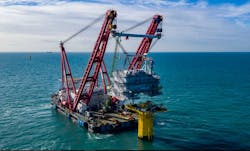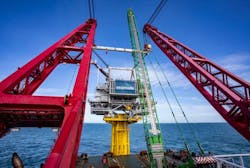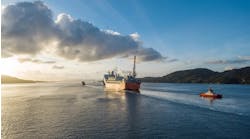Total takes major stake in offshore Wales floating wind project
Total has signed an agreement with developer Simply Blue Energy to acquire an 80% stake in the floating wind project Erebus in the Celtic Sea, offshore Wales. The facility, which will be installed in a water depth of 70 m (230 ft), will have a 96-MW capacity.
Total said the UK was the world’s largest offshore wind market, and that although most developments to date have been in shallow waters, based on fixed bottom technology, floating wind offshore appears set for strong growth.
This technology has the potential to open access to locations farther offshore, which have less impact on the landscape, as well as stronger wind resources.
According to Simply Blue, the WindFloat floating foundation for offshore wind turbines cuts environmental risk and cost.This is due to its relatively simple assembly and installation requirements, with all heavy lifting operations performed in a protected environment on dry land (i.e. at the port) using onshore cranes and transportation methods such as tugboats, instead of more costly offshore installation vessels.
“Total has the appropriate skills to meet the technological and financial requirements that determine the success of future floating offshore developments,” said Patrick Pouyanné, chairman and CEO.
Siemens Gamesa to provide turbines for two German wind farms
Ørsted has conditionally named Siemens Gamesa Renewable Energy as the preferred turbine supplier for two offshore wind power projects in the German North Sea.
At both the 900-MW Borkum Riffgrund 3 and the 242-MW Gode Wind 3 sites, Siemens Gamesa will deploy its new SG 11.0-200 DD offshore wind turbine. A five-year service and maintenance agreement is included in the preferred supplier award.
The SG 11.0-200 DD offshore wind turbine features a 200-m (656-ft) diameter rotor using the 97-m (318-ft) long Siemens Gamesa B97 IntegralBlade.
The award is subject to certain conditions including Ørsted’s final investment decision, which itself is subject to the projects receiving final grid dates and final consents from German authorities.
The Borkum Riffgrund 3 project will be the largest offshore project in Germany to date, according to Ørsted.
The final number of turbines for both projects remains to be determined. Ørsted expects the installation of Gode Wind 3 to begin in 2023, with commissioning being completed in 2024. The installation of Borkum Riffgrund 3 is expected to begin 2024, with commissioning being completed in 2025.
Moray East piles installed
DEME Offshore has completed foundation piling operations at the Moray East offshore wind farm in the UK.
The company’s installation vessel Apollo installed 309 piles in what was said to be a complex and varied seabed geology.
The company developed a piling template that was designed to integrate with the jackup legs of the Apollo. It also developed an underwater drilling tool to cope with hard and rocky layers and relief drilling to install the piles in these challenging conditions.
As part of the second stage of offshore works, the company’s newbuild installation vessel Orion will integrate 103 jacket foundation structures and three topside modules.
SeaMade substations installed offshore Belgium
Scaldis’ heavy-lift vessel Gulliver has installed the two 1,200-metric ton (1,323-ton) substations for the SeaMade offshore wind farm in the Belgian North Sea.The substations transform the wind energy that is produced to 225 kV, which in turn allows the electricity to be brought to shore via Elia’s Modular Offshore Grid. DEME’s cable installation vessel Living Stone installed the export cable which transmits the electricity to shore.
ABB to power Japan’s wind turbine installation vessel
Japan Marine United Corp. has contracted ABB to provide power and control technologies for the wind turbine installation vessel it is building for Shimizu Corp. This is the first self-elevating wind turbine installation vessel built in Japan.
ABB will deliver a closed ring configuration for the vessel’s DP operations, as well as delivery and system integration of generators, high voltage switchboard system, the variable speed drives and motors for main propulsion and bow thrusters, and the power and energy management system. The 28,000-gross tonnage vessel is expected to be delivered in 2022. •





